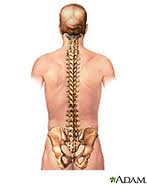What is an Inter-Spinous Process Device such as coflex®?
Considered a ‘cutting edge procedure’ for spinal stenosis, coflex® has been in the news for its recent (2012) FDA-approval and for being the first and only motion-preserving minimally-invasive device for moderate to severe spinal stenosis (narrowing of the spinal canal) whose use also involves decompression, or removal of portions of bone and ligament that are narrowing the spinal canal.
The coflex® Interlaminar Technology is an Interlaminar Stabilization™ device indicated for use in one or two level lumbar stenosis from L1-L5 in skeletally mature patients who have undergone at least six months of non-operative treatment for spinal stenosis pain, as well symptoms of leg/buttocks/groin pain, with or without back pain. In other words, it can be used across 1 or 2 symptomatic narrowed spinal regions in adults who have had 6 months of treatment such as physical therapy, injections, and medications. The coflex® is placed behind the spinal canal in the area where bone was removed to widen the spinal canal, and takes some pressure off the joints along the back of the spine.
What are the Benefits?
Based on the FDA clinical study, when compared to spinal fusion surgery, patients receiving the coflex® device experienced:
- Shorter operating time and hospital stay
- Quicker recovery
- Faster and sustained pain relief
- More motion within the spine in the treated area
More specifically, a study in which the Spine Institute participated found that:
- Coflex® patients spent 40% less time in the hospital compared to fusion surgery patients (1.90 vs. 3.19 days), and coflex® surgeries were faster compared to fusion (98 vs. 153 minutes).
- At two years’ follow-up, 85.8% of coflex® patients showed significant improvement in pain and function, compared to 76.7% of fusion patients.
- At two years’ follow-up, coflex® patients retained the range of motion at the treated level they had before surgery; however, fusion patients experienced 62% motion reduction at the treated level.
Initial trials, then, show promising results, and find that coflex® may be an option for patients with narrowing of the spinal canal and can sometimes avoid the need for spinal fusion in combination with relieving the pressure on spinal nerves..
We are using this device cautiously and are awaiting further results from trials, encouraged to find that initial trials are looking good. Talk to your spinal surgeon about whether or not you would be a good candidate for coflex® implants to help solve your spinal stenosis issues. to achieve long-term relief and improved quality of life.








